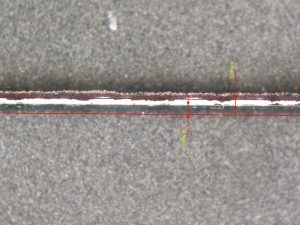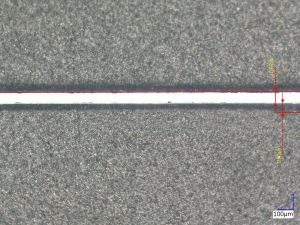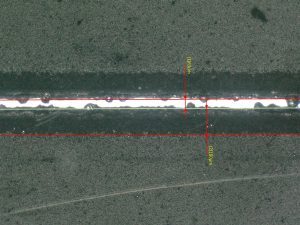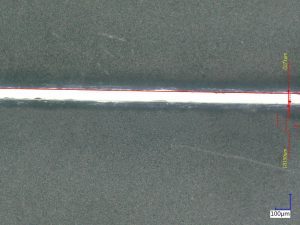Sonplas GmbH, an established provider of high-quality assembly and testing equipment for the automotive industry, is contributing with a newly developed method for processing electrodes, to a more efficient and sustainable production of battery cells for the booming electro-mobility.
As a partner over several years for the automotive industry, Sonplas GmbH based in Straubing is most conversant with the high level of demands on quality from this industry. Since over 10 years, the engineers at Sonplas are now also giving an impetus in matters of quality with their innovative ideas in the field of electro-mobility.
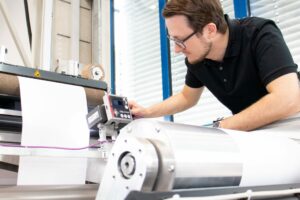
Roll-to-roll demonstrator for cutting electrode sheets. The electrode foils are unwound, cut with the laser and rewound or stacked individually.
The Lower Bavarian company with more than 300 employees has been developing, building and supplying customised, innovative testing and assembly systems for the automotive, automotive supplier, electronics and aerospace industries for almost three decades.
Apart from the assembly of rotors, inverters and other components for electrically driven cars and utility vehicles, Sonplas is also occupied with the production of battery cells for both automotive as well as non-automotive applications. An important aspect in the process is achieving optimised cut edges while creating the electrodes for battery cells in order to counter international competition, first and foremost the established market competitors from Asia with a new level of quality “Made in Germany”.
At present, the manufacturing methods and standards applied in the cell factories for processing lithium-ion battery foils, often do not meet the required level of quality for the automotive industry. Apart from enhancing the quality, primarily of the cut edge and avoiding particles, the aspired rate of rejects during production, improved quality and extended service life of the cells also depend on this. For this purpose, Sonplas has developed a new approach during laser cutting and suction compatible and adjusted to the former.
Optimum laser cutting on electrode foils
Currently, three cell formats are used in the production of lithium-ion batteries in electro-mobility: the pouch cell, the cylindrical cell and the prismatic cell. Irrespective of the cell type, the smallest unit of each lithium-ion cell consists of two coated foils, the electrodes. One is a coated copper foil for the anode and the other is a coated aluminium foil for the cathode. In electrode production, these carrier foils are coated with electrode material on large mother rolls. Then they are separated onto daughter rolls to get the required formats of the cells. The next step is to trim the edges of the daughter rolls or cut out the individual electrode sheets (Separation). Compared to the mechanical punching method still used widely, modern laser systems offer considerable benefits with respect to quality, flexibility and operational costs.
Speed, cleanliness and flexibility count
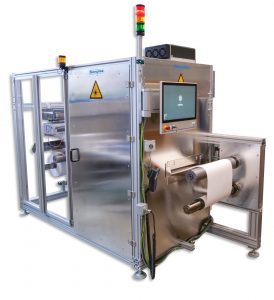
Demonstration system at the head office of Sonplas GmbH in Straubing. Customers get the opportunity of performing tests with own materials.
In order to enhance productivity, the notching of the battery foils is carried out in the roll-to-roll method. In the process, there are demanding technical problems to be solved. Florian Thalhofer, development engineer at Sonplas, is already involved with this process since several years: “The real problem lies in a combination of challenges. We have a very high cutting speed of considerably more than 1 metre per second. The electrodes must not get contaminated. Above all, not with particles that are larger than 10 µm, since otherwise the separator foil can easily get punctured. In addition, it needs a system with the help of which we can process various geometries without converting or retrofitting the system such as, e.g. the largest commercially available electrodes in the processing range of 700 x 700 mm and beyond.” A highly complex operation that calls for maximum precision at high speeds and needs to be flexible and adjustable at the same time.
An innovative laser process with a novel approach for suction could be developed in a comprehensive innovation project that was carried out jointly with scientific institutes and partners from the industry.
Florian Thalhofer: “Among other things, it was important to us to reduce the so-called HAZ (heat affected zone), that is, the heat influencing zone on the material. In addition, there should neither be any so-called burn-back, which is loss of contact material of the coating while cutting, nor any burr formation. We even wanted to reduce the particle size and number of particles.” As the results show, these objectives could be met. In doing so, the innovative process is available to customers for evaluations or sample products not only under laboratory conditions, but also in a proof-of-concept system that is close to production capability. “The better cut in the electrode foils means that we can make the production more sustainable and enhance the service life of battery cells,” says Paul Birkeneder happily, with Sonplas in sales. Moreover, the company has developed a method for general assessment of the quality of electrode notches based on measurable quality criteria. An appropriate automatic inspection station is also available with customers for evaluations. The special machinery manufacturer, Sonplas GmbH based in Straubing, is working together with RAYLASE GmbH for the development of the laser process.
By combining the Lower Bavarian company’s expertise in special machine construction with the innovative laser deflection units of the Upper Bavarians, from two researching companies, they have been able to achieve a high-quality laser notch on the electrode foils to be separated. This not only supports the current highly dynamic growth of battery production in Europe, and in Germany in particular, but also improves the ecological and economic balance of production. The reason is that better quality helps to reduce the currently high level of rejection rates currently seen in cell production.
- Graphite anode coated on both sides with 260 μm thick layer before.
- After: The result from Sonplas – a clear edge without loss of contact material.
- A laser-cut edge of a cathode of 230 μm thickness with Lithium-Nickel-Manganese-Cobalt oxide coating before.
- After with Sonplas technology: no slugs or beads formed and a smaller heat influencing zone.
